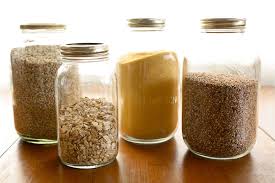 I have never been a big fan of plastic. I remember in the 1980s, when microwaves became a common household item and people were using plastic containers to heat their food in the microwaves. It seemed very wrong, even though the containers were marked “microwave safe.” Sometimes, if the container was left too long in the microwave, it would start to melt/bend with the food it in. Common sense told me that plastic, which was made from petroleum oil, was leaching into the food that was heated. Most of my friends and family thought I was crazy. Years later, I unfortunately have been proven correct.
I have never been a big fan of plastic. I remember in the 1980s, when microwaves became a common household item and people were using plastic containers to heat their food in the microwaves. It seemed very wrong, even though the containers were marked “microwave safe.” Sometimes, if the container was left too long in the microwave, it would start to melt/bend with the food it in. Common sense told me that plastic, which was made from petroleum oil, was leaching into the food that was heated. Most of my friends and family thought I was crazy. Years later, I unfortunately have been proven correct.
Currently, there is debate about Bisphenol A (BPA), a chemical produced in large quantities used primarily in the production of polycarbonate plastics and epoxy resins. It can be found in food and drink packaging, water and infant bottles, compact discs, impact-resistant safety equipment, register receipts, and medical devices, along with some dental sealants and composites. Epoxy resins are used as lacquers to coat metal products such as food cans, bottle tops, and water supply pipes. The degree to which BPA leaches from polycarbonate bottles into liquid may depend more on the temperature of the liquid or bottle, than the age of the container. Therefore, heating the container in the microwave or washing it in the dishwasher can breakdown the plastic and increase the leaching into food.
Okay, what’s so bad about BPA? Well, it’s an endocrine disruptor. An endocrine disruptor is a chemical that interferes with the body’s endocrine system and produces adverse developmental, reproductive, neurological, and immune effects in both humans and wildlife. An endocrine disruptor mimics estrogen, a natural hormone, and fools the body by stimulating reactions that are unnecessary and potentially harmful. Scientists have linked BPA to a higher incidence of heart disease, diabetes and liver abnormalities in adults as well as brain and hormone development problems in fetuses and young children. Other tests have shown that BPA can promote human breast cancer cell growth, decrease sperm counts in rats, and cause erectile dysfunction and other sexual problems in men. What’s even scarier is that BPA is found in most people. In 2,000 people tested, over 90 percent had BPA in their urine. Traces have also been found in breast milk, the blood of pregnant women and umbilical cord blood. The FDA is finally starting to hear public concerns and as of July 18, 2012, banned it in baby bottles and Sippy cups. Well it’s a start I guess, but more needs to be done.
The thing that makes BPA appealing for plastic-makers is that, health concerns aside, it’s pretty darn useful. BPA is a plasticizer, which makes it a useful part of the plastic in can linings and in certain types of plastics, and it works well as a color developer for inkless papers, like carbon copy paper and the thermal paper that we use to print receipts. Manufacturers can’t just take BPA out of products. They have to replace it with something, and the something that many manufacturers have chosen is BPS, a “sister chemical” to BPA.
BPS shares many of BPA’s beneficial properties, but unfortunately, it has another property in common with BPA: it also mimics estrogen, which means it probably is just as unhealthy for us as the BPA it’s replacing. Of course, not all BPA free products contain BPS, but the trouble is that there’s no way to know which ones to avoid.
 So, what can you do to avoid BPA and BPS? (which is very difficult nowadays)
So, what can you do to avoid BPA and BPS? (which is very difficult nowadays)
- Plastic containers have recycle codes on the bottom. Some, but not all, plastics that are marked with recycle codes 3 or 7 may be made with BPA.
- Avoid putting your food and drinks in plastic. Use a metal, porcelain or glass containers. Anchor has fabulous glass containers, made in the USA. Yes, some of the tops are plastic but you don’t have to fill the container all the way to the top, do you? Or simple reuse jars.
- Do not heat your food in plastic containers in the microwave.
- Wash all plastic containers by hand and avoid the dishwasher.
- Reduce your use of canned foods and soda. Eden Foods steel cans are coated with a baked-on inside lining called oleoresinous enamel made from a mixture of oil and a resin from various plants, such as pine or balsam fir. It is the same type of material in widespread use before epoxy resins made with BPA became the industry’s standard can liner in the late 1970s.
- Skip the receipt and avoid carbon paper. Any inkless papers could contain BPA. Receipts that are printed with an ink printer should be OK.

Like this:
Like Loading...
The other day I read that an Iowa State University research group showed that the essential oil found in the herb catnip Nepeta cataria is about 10 times more effective than DEET in repelling mosquitoes in the laboratory. What a wonderful discovery!
